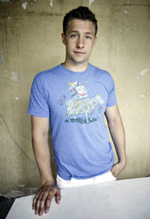Public Art

'Follow Me' by Jeppe Hein (photo by Jamie Woodley)
The University of Bristol commissioned a major work from internationally acclaimed artist Jeppe Hein as part of its centenary celebrations. The work is permanently sited in the University’s historic Royal Fort Gardens, which are open to the public. The official unveiling took place on 5 October.
The work
Jeppe Hein’s works often involve and surprise people by encouraging them to interact with one another and with the works themselves, and by playing optical tricks. His piece for the University’s centenary is no exception and invites audiences to engage with it in very direct ways.
Hein says that the work is ‘inspired by the notion of the University as a place of learning and self-discovery’ and that it is partly a response to the history and character of the site. The University is confident that the piece will interest, challenge and inspire generations of students, staff and visitors.
The artist

Jeppe Hein (photo by Anne Mie Dreves)
Born in Denmark in 1974, Jeppe Hein has achieved international recognition for his imaginative, witty and playful works. Some of his work is on display in Tate Modern and the Saatchi Gallery and he recently participated in Channel 4’s Big Art Project.
His work has been included in numerous international exhibitions including Frieze Projects, London (2008); The World as a Stage, Tate Modern, London and the Institute of Contemporary Art, Boston (2007); Flying Cube, P.S.1 and MOMA, New York (2004); and the Venice Biennale (2003).
Hein lives and works in Copenhagen and Berlin.
On Sunday 4 October, Jeppe Hein was interviewed about his work by Claire Doherty of Situations.
The location
Royal Fort Gardens are listed Grade 1 and represent part of a large, 18th-century estate that belonged to the wealthy Tyndall family. The gardens form the grounds of Royal Fort House, which was built between 1758 and 1761 in Baroque, Rococo and Palladian architectural styles.
In 1799 the grounds were landscaped by Sir Humphry Repton, England’s pre-eminent landscape gardener at the time. Combining garden design with elements of Romantic landscape painting, he introduced irregular sight lines, winding paths and reflective surfaces of water to give the illusion of depth and space, and to add detail and interest.
Jeppe Hein was interested in creating a work for Royal Fort Gardens partly because he felt an empathy with Repton’s distinctive and imaginative approach.
The background
The University established a Centenary Public Art Committee, chaired by Professor Martin White, to work in partnership with Situations, a commissioning and research programme based at the University of the West of England, to identify and select an artist. Ten outstanding artists were considered, of whom three were invited to Bristol to present their work and develop a proposal.
Hein was selected because the committee was convinced of his ability to produce a striking, engaging work that will add significant long-lasting value to the cultural life of the University and Bristol.
Situations oversaw the curation and installation of the work.
The commission was developed in close consultation with Bristol City Council, English Heritage and experts in archaeology and landscapes.